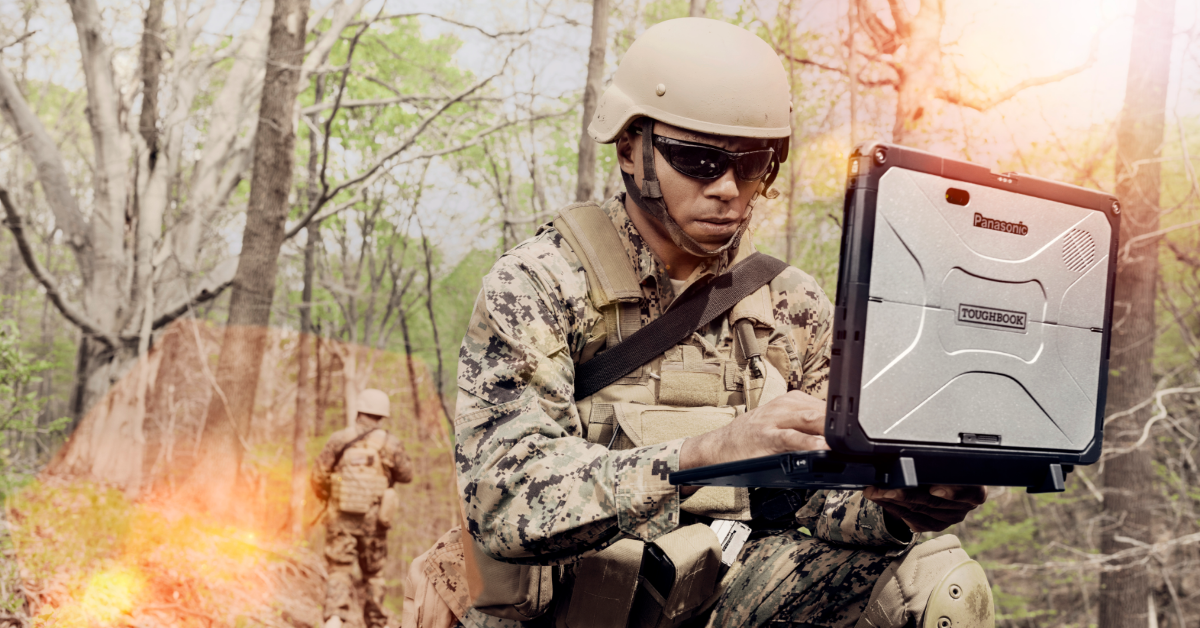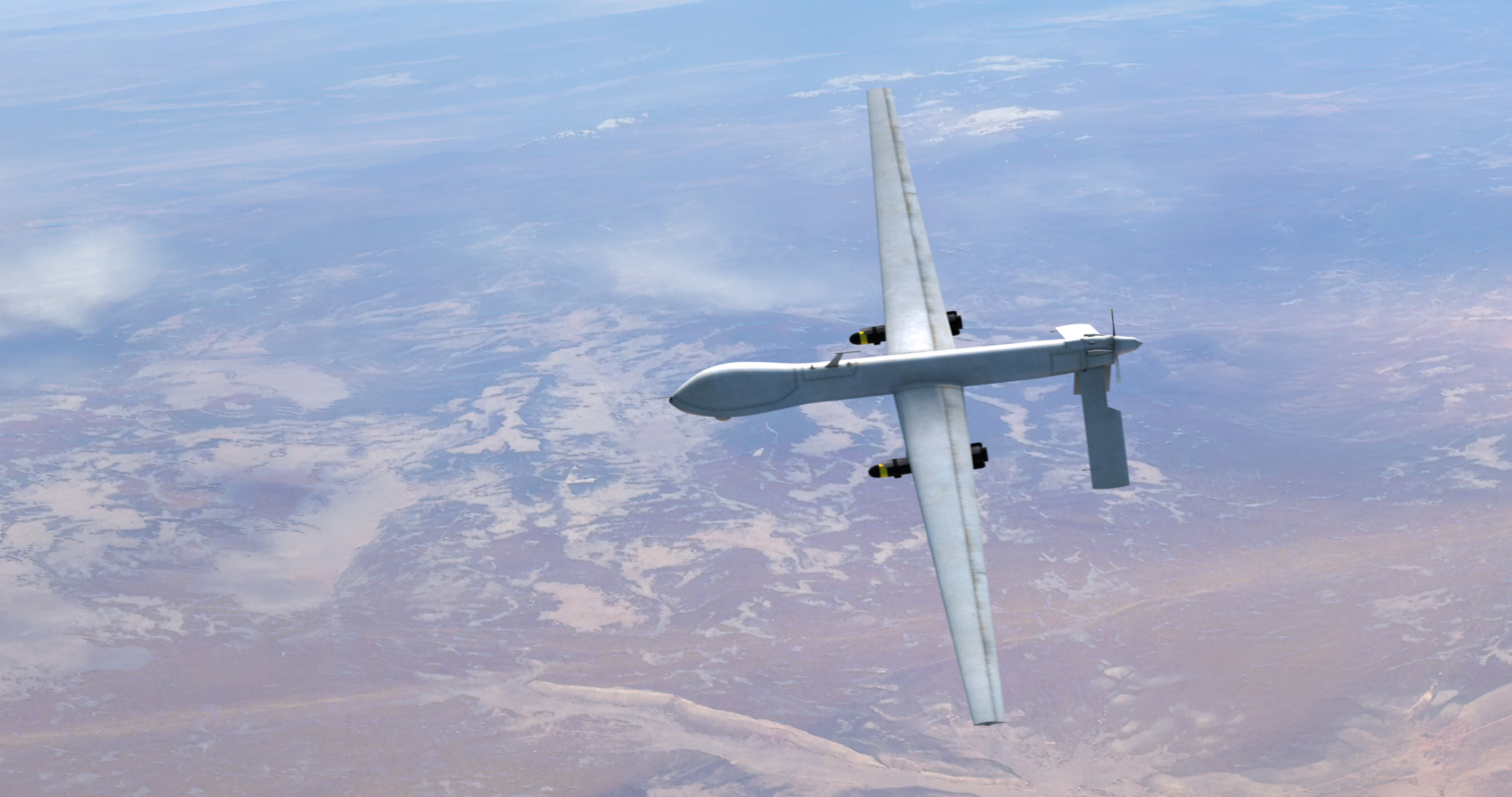Why Rugged Devices Make Excellent Military Technology
Whether in active combat situations, conducting critical maintenance and repairs, or planning command and control operations, military personnel require the most powerful cutting-edge technology available. There is no room for error in military operations with lives on the line. That’s why the right military technology includes rugged technology, which can handle the extreme conditions and demanding applications our military personnel face every day.
Defense technology must be tough inside and out: the hardware and software need to withstand punishing external conditions while also providing necessary cybersecurity. These devices must be capable of carrying out a wide range of functions so military personnel can minimize pieces of equipment in the field. And no matter where they are — from the deck of an aircraft carrier on the open ocean to remote combat locations — their technology must be reliable, available, and provide connectivity when appropriate.
We designed our rugged computers to meet these challenging conditions, making TOUGHBOOK laptops and mobile devices a preferred choice of the U.S. military. But it’s not only today’s conditions that TOUGHBOOK devices are built for — they’re ready for tomorrow’s challenges as well.
Military technology must be tough
Military laptops and mobile devices must be capable of handling bumps, drops, vibrations, and more as they travel between the field and office. To ensure that our technology is up to the task, we test our rugged devices to meet or exceed MIL-STD-810G and MIL-STD-810H. While tough, TOUGHBOOK devices are customizable with expansion packs (xPAKs) to meet various requirements.
Just as crucial as physical toughness is their ability to stay connected —or not— anywhere. We test TOUGHBOOK devices to ensure they consistently connect (as appropriate) to military networks, whether in maintenance depots or in the field. With pass-through antennae built in, these laptops and devices can use several wireless protocols simultaneously or choose the best available options. They’re equipped to use 4G, 5G (supporting sub-6, C-band and mmWave) or WiFi. These capabilities ensure that TOUGHBOOK devices can maintain mission-critical connections.
Mobility is critical for success in the field
Military personnel need their technology to move with them, not hold them back. Troops conducting tactical missions in particular need devices with a small footprint. We offer rugged tablets and 2-in-1 solutions like the TOUGHBOOK G2 and TOUGHBOOK 33, which can attach a keyboard to function as a laptop and then disengage to seamlessly switch back to a tablet. This ability allows for quick input via the touchscreen or longer report writing with the keyboard, your situation dependent.
Mobility is also key for personnel conducting repairs and maintenance. Navy and Air Force personnel, for example, use TOUGHBOOK devices on ships and aircraft carriers to access manuals and maintenance data digitally, rather than thumbing through paper manuals and binders.
This level of mobility can be vital for military personnel to complete necessary repairs on critical equipment, putting maintenance data at technicians’ fingertips quickly and efficiently.
Modularity supports military personnel during missions
Military operations require numerous actions simultaneously and the ability to pivot to new orders and changing conditions. Our armed forces can’t waste any time or effort switching between devices in the field or at command locations — they need to have one rugged device that can handle multiple functions.
TOUGHBOOK modular laptops and tablets feature expansion packs (xPAKs) to provide the customizability and flexibility that military personnel need. These capabilities ensure that soldiers can complete tasks without juggling multiple devices, nor do they have to send devices to be reconfigured when stationed in remote locations. With xPAKs, military personnel can plug in diagnostic tools, additional drives, external readers, and other devices to complete their work with just one rugged device.
xPAK options include:
- Serial ports for plugging in diagnostic equipment
- Fingerprint reader
- USB-A ports
- HDMI
- Audio, Blu-Ray and DVD drives
- Microphone
- Hot-swappable batteries
- Barcode readers
- Optical drives
- Authentication readers
The TOUGHBOOK 40 also includes expanded memory and user-replaceable storage to handle large amounts of data. This military grade laptop features eight modular areas for industry-leading flexibility.
Military technology is either AI-ready or obsolete
The U.S. military is no stranger to advanced technologies, and like industries everywhere, it’s incorporating AI-driven solutions to improve efficiency and productivity. AI can support intelligence gathering, simulate battlefield conditions, and improve equipment maintenance. For example, predictive maintenance can streamline scheduling and reduce equipment downtime by prioritizing work before an issue occurs.
Augmented reality (AR) and the Internet of Things (IoT) are also changing the way military personnel interact with their technology — with AR capabilities, technicians can enable 3D, first-person equipment displays and share critical information on maintenance and repair operations (MRO).
Rugged laptops and mobile devices must be capable of handling vast amounts of data and have the computational power to run these advanced programs. That’s why TOUGHBOOK computers include high-end CPUs and GPUs for greater capacity.
Military laptops and devices power unmanned aerial systems
The U.S. military is increasingly using drones and unmanned aerial vehicles (UAVs) as well as land-based robots for critical activities. These machines perform reconnaissance, collect intelligence, and improve situational awareness. UAVs are also being used to deliver supplies to the field, and robots are crucial for highly dangerous maneuvers like explosive ordnance disposal.
In all of these applications, a human-operated controller handles navigation and data collection. The device powering that controller is the heart of the system, and it cannot be a point of failure. TOUGHBOOK has the computing power and ability to support the operating systems that drive these complex pieces of military hardware. while protecting those components with typical TOUGHBOOK ruggedness.
This military technology must also be rugged enough for conducting operations anywhere and at any time. The TOUGHBOOK 40, for instance, features AMD-dedicated graphics or optional Intel Iris Xe graphics that support high-end imagery and large amounts of video data from drone feeds. TOUGHBOOK screens are visible at night or in bright sunlight if the device is used in the field. All controllers must also have long battery life — a problem TOUGHBOOK solves with hot-swappable batteries.
Different unmanned systems require different types of controllers, so Panasonic Connect offers different TOUGHBOOK options to meet the military’s needs. A tablet like the TOUGHBOOK G2 is easily portable for field operations, while the TOUGHBOOK 33 is a larger form factor for longer-range deployments where an operator is seated. TOUGHBOOK devices are powerful enough to handle any remote operations while also being configurable for whatever type of unmanned system they’re called upon to control.
Supply chain agility is mission critical
The Department of Defense (DoD) listed “resilient and agile logistics” as a key objective in 2018, and rugged technology remains critical to meeting this goal. Maintaining supply lines can be a matter of life and death, and the military needs technology that provides real-time updates between supply depots and inventories, and the troops in the field.
As supply chains become more sophisticated, military technology must be equally cutting-edge. For example, the U.S. Army explored the viability of a UAV delivering 600 pounds of supplies to frontline soldiers. Panasonic Connect devices like the TOUGHBOOK 55 and TOUGHBOOK 40 feature the processing power to support these operations, as well as an infrared webcam for monitoring supplies and all-day battery life to ensure operational execution.
With their pass-through antennae and ability to use 4G, 5G or WiFi connections, TOUGHBOOK devices are designed to maintain the connectivity required for coordinating supply lines and maintaining communication. They allow personnel to access multiple logistics systems and make real-time updates. TOUGHBOOK computers are engineered to carry out lengthy, complex operations that are inherent to military supply logistics, thereby keeping our troops informed, supplied, and connected to their command centers.
Maintenance and repair operations require rugged technology
In 2022, over 50% of the DoD’s budget was allocated to maintenance and repair operations (MRO). Military assets are complex, cutting-edge machines with advanced technological capabilities, and it takes significant investments to keep them performing at the highest level. Every hour that a tank is in operation requires six hours of regular maintenance, for example, and an F-16 fighter jet requires 17 hours of maintenance for every flight hour.
How can rugged devices support and even improve MRO? By automating workflows, aggregating disparate data sources, and even anticipating when maintenance is needed, rugged laptops and mobile devices can streamline MRO for all branches of the military. Digitized maintenance manuals are a major improvement over paper-based versions, and military technicians can access schematics, repair instructions, and part numbers without flipping through pages of information or across multiple documents.
With a military-grade laptop or mobile device, documentation of repairs and maintenance activities is digitally accessible for improved auditing. And applying advanced analytics to all the collected data can support predictive maintenance efforts, identify fleet- or system-wide issues, and quickly push information to field personnel.
Connectivity and modularity are key to improved MRO as well. Military technology must be able to run diagnostics on all types of assets and keep in contact with field operations and command centers. TOUGHBOOK devices provide this reliability with pass-through antennae designed for constant connectivity, and with their xPAKs, these laptops and mobile devices can run all types of equipment, even AR for remote repair operations and complex maintenance tasks.
Military technology needs world-class cybersecurity measures
Military operations require the utmost security at all times, and cybersecurity breaches put lives in danger. This is why the U.S. military has procurement requirements in place under the Trade Agreements Act (TAA), but the complexity of today’s supply chains means security measures can still fall through the cracks. A U.S.-based chipmaker, for example, had components compromised during manufacturing processes in China.
These breaches can happen if final assembly takes place in TAA-compliant countries but manufacturing or parts sourcing happens in non-compliant countries. Panasonic Connect addresses this issue by manufacturing and assembling critical components in TAA-compliant countries and even assembling circuit boards in its own facilities. This allows us to ensure TOUGHBOOK devices are TAA compliant.
These rugged devices also include security measures right in their software. These include:
- Sandbox capabilities to prevent apps from accessing data they don’t need.
- Software-based data encryption.
- Remote Secure Wipe option on the TOUGHBOOK 40, which securely removes all contents from the device’s drive in less than 10 seconds.
- Biometric and smartcard readers for multi-factor authentication without using multiple devices.
TOUGHBOOK devices are equipped with security measures to counter those threats and keep military personnel and data safe and secure.
Rugged defense technology lowers the total cost of ownership
With all their state-of-the-art features, TOUGHBOOK devices have a higher initial investment cost than consumer devices. However, their extremely long life cycles and low failure rate mean they have a lower total cost of ownership (TCO).
In fact, TOUGHBOOK devices are more reliable than other rugged devices based on failure rates. They require fewer repairs and replacements than other devices on the market, and thanks to their modularity, one TOUGHBOOK can handle a variety of tasks, reducing the need to purchase multiple devices for each service person.
Panasonic Connect also provides 24/7 U.S.-based customer service and support so that any damages or issues can be resolved quickly. TOUGHBOOK computers are covered with a standard, industry-leading warranty, and our service teams quickly get devices back into the hands of military personnel who need them. Professional services for TOUGHBOOK devices include:
- Pre-deployment consulting
- Engineering design and field engineering expertise
- Deployment services, such as imaging and asset tagging
- Warranty coverage and maintenance services
- Hard drive replacement
- End-of-life recycling
Overall, this equates to taxpayer savings and budget efficiency for all military branches. Not only are TOUGHBOOK devices powerful enough to help keep our military personnel safe, they’re also a good investment.
Rugged technology keeps our military effective
The strongest military in the world needs the toughest technology to support its missions. The features included in TOUGHBOOK devices enhance the field capabilities of today’s armed forces, and they keep them prepared for evolving threats in the future. Our armed forces require the most advanced military technology, and with TOUGHBOOK devices, they’ll have it whenever and wherever necessary.
![]()



